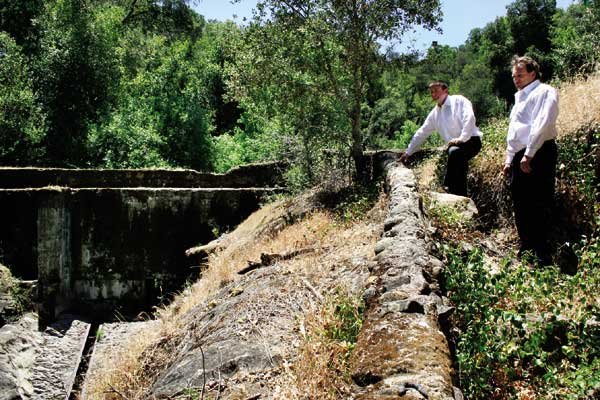The city administrator has tentatively rejected an offer to buy
Gilroy’s water from a San Francisco millionaire, but the persistent
businessman to the north claims corruption and vows to keep
fighting.
The city administrator has tentatively rejected an offer to buy Gilroy’s water from a San Francisco millionaire, but the persistent businessman to the north claims corruption and vows to keep fighting.
Citing environmental concerns and legal uncertainties related to the potential purchase of water from Luke Brugnara’s seasonal reservoir along Little Arthur Creek, northwest of Gilroy, City Administrator Tom Haglund wrote in a letter to Brugnara Tuesday that Gilroy “has determined that any consideration of the (water deal) is premature at this juncture.”
Water coming down Mount Madonna flows into the Little Arthur Creek on Brugnara’s 112-acre property along Redwood Retreat Road and then feeds the Uvas Creek before percolating into the aquifer below Gilroy. Instead of paying the Santa Clara Valley Water District $2.4 million a year to pump nearly 3 billion gallons of water from the aquifer (which it helps replenish by releasing water from the Uvas Reservoir), Brugnara has offered to sell “his” water in arrears for $300,000 a year for the first two years and then at a 15-percent markdown from the district’s prevailing rate thereafter.
Haglund called the entire premise of the proposition “puzzling” because, he wrote, it seems like Brugnara is trying to profit off the way water flows now: It already leaves Brugnara’s property and travels down Uvas Creek along with the district’s artificially released water, so why would the city pay him on top of the water district? Simple, Brugnara has said: Just dump the “God-like” water district and start paying him instead.
That assumes, however, that Little Arthur Creek creek, which now runs dry, has enough flow during the wet season to quench the city for an entire year, especially if the district cuts off some or all of its releases from Uvas Dam. While a water district meter just downstream from Brugnara’s property (and just upstream from the Uvas Creek intersection) has recorded an annual flow of about 1.5 billion gallons, it is unclear if that water passed through Brugnara’s dam or came from separate tributaries below it. Brugnara has claimed the latter and said the dam holds back the water he plans to sell, but Haglund wrote that the city needs scientific evidence to back up these claims. The property’s long-time previous owners have also questioned the volumes Brugnara has reported.
Still, in his written response to Haglund’s letter, Brugnara called the rejection “not surprising considering your limited experience in administrative matters for larger municipalities.” Haglund came to Gilroy earlier this year as the Deputy Manager of Hanford, a city roughly the size of Gilroy with about 50,000 people.
Brugnara added, “There is clearly a conflict of interest between several members of the city and (water district Board of Directors Vice-Chair) Sig Sanchez.” Sanchez, a former Gilroy mayor, has denied the allegation as vehemently as Brugnara has denied federal charges against him for poaching endangered fish from Little Arthur Creek.
“I must remind you,” Brugnara went on in his letter to Haglund, “that you are not the final decision maker for the City of Gilroy and this matter in fact will be heard and voted on by the city council of Gilroy in September when all the facts are presented so they can make an objective decision based upon the needs of the citizens of Gilroy.” For the water sale issue to come up before the council, Haglund or a council member must recommend it be placed on an upcoming agenda. So far nobody has done that for either of the council’s regular September meetings, according to City Clerk Shawna Freels.
That includes Councilman Perry Woodward, who has visited Brugnara’s property and talked to him extensively.
“I stand by the work that Tom (Haglund) did and the opinions expressed in his letter, so it is not my expectation to override (Haglund),” Woodward said.
As for his indications to Brugnara that the council would formally consider the water sale, Woodward said: “Bringing this item before the council was based on my optimism that (Haglund’s) investigation would come back positive, but what his investigation revealed is that there are still a lot of questions that need to be answered by Brugnara and his legal counsel before we can go forward … I don’t think it will be on the agenda for September.”
If it does come before the council, though, Brugnara has vowed to show up with one of the state’s top water rights law firms, Kronick, Moskovitz, Tiedemann & Girard. Backed by his counsel, Brugnara has affirmed the legality of this deal and his grandfathered right to sell the water. He has also chastised Haglund for not hiring an independent legal counsel to correspond with KMTG.
Any legal discussion would center on state law that affords water sale rights to dam operators who have continually used blocked water for beneficial reasons since at least 1914. While the the State Water Resources Control Board, the agency concerned with water rights, has partial records related to Brugnara’s dam dating back to 1911, nothing exists to positively affirm the exact construction date or its dependent grandfathered status, as Haglund noted in his letter.
As for first-hand knowledge, the property’s previous owners and neighbors have confirmed that the dam’s former operators would close and open it depending on stream flow and, later, fish migrations. But when they described the reservoir’s seasonal capacity, estimations fell far short of the immense volume Brugnara has proposed to sell.
The property’s former owners have also called into question the dam’s continual use leading up to Brugnara’s purchase of the land in 2001. If a dam goes out of continual use for more than five years, it loses its grandfathered status, according to state law. Even if the dam had a grandfathered status at one point, it likely lost that benefit as the property fell into disrepair during the late 1980s and 1990s, according to the property’s previous owners.
There are also environmental concerns relating to endangered steelhead trout, which swim up Little Arthur Creek, above Brugnara’s dam to spawn via a so-called “fish ladder.” While Brugnara has insisted his dam’s indeterminate age trumps subsequent federal legislation concerning endangered species, the California Department of Fish and Game – which enforces endangered species legislation on the state level – has wholeheartedly disagreed, pointing out that the creek is listed as an essential spawning ground for the steelhead. As a result, the dam must remain open during the fish’s migratory period between December and June. That time coincides with the bulk of the rainy season.
The water control board, a subsidiary of the California Environmental Protection Agency, has also required a pre-1914 dam to facilitate endangered species once before, according to board Spokesperson David Clegern. And although new water diversion permits specifically include endangered species caveats, that does not exempt pre-1914 arrangements, Clegern wrote in an e-mail.
“If Brugnara really claims pre-1914 rights, he probably doesn’t have a
permit, but we will enforce the Endangered Species Act,” Clegern wrote. “Water diverters are subject to the requirements of the state and federal endangered species acts.”
Brugnara has argued that all this is a non-issue, though, because his company has agreed to indemnify Gilroy should the water district or some other agency raise their legal sword. Matters became more complicated for Gilroy, though, when Haglund considered Brugnara’s own legal travails.
“The city cannot help but note that you are presently under federal indictment by the U.S. Department of Justice for violations of the Endangered Species Act directly related to activities at the Brugnara Dam,” Haglund wrote. He also noted three federal counts of income tax evasion again Brugnara that could jeopardize his promise to defend the city in case of any legal action brought against it.
Despite all the uncertainties and concerns, Brugnara has vowed to push the deal ahead in the name of saving residents money.
“This matter will be heard and voted on by the city council in September with or without your approval,” Brugnara wrote to Haglund. “The citizens of Gilroy deserve to save millions of dollars and will not be denied.”
Check back for updates on this story, including interviews with former property owners, neighbors and water and fish experts.













